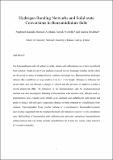Hydrogen bonding networks and solid-state conversions in benzamidinium salts

View/
Date
2015-07-14Author
Kamali, Naghmeh
Aljohani, Marwah
McArdle, Patrick
Erxleben, Andrea
Metadata
Show full item recordUsage
This item's downloads: 513 (view details)
Cited 10 times in Scopus (view citations)
Recommended Citation
Kamali, Naghmeh, Aljohani, Marwah, McArdle, Patrick, & Erxleben, Andrea. (2015). Hydrogen Bonding Networks and Solid-State Conversions in Benzamidinium Salts. Crystal Growth & Design, 15(8), 3905-3916. doi: 10.1021/acs.cgd.5b00529
Published Version
Abstract
Ten benzamidinium salts of carboxylic acids, amides, and sulfonamides have been crystallized from solution. Single-crystal X-ray analyses revealed various hydrogen bonding motifs which ate discussed in terms of supramolecular synthons and graph sets. Benzamidinium hydrogen maleate (5a) crystallizes as large,needles of up to >3 cm in length. Attempts to influence the crystal habit and size through a change of solvent and the presence of additives yielded a second polymorph (5b). The formation of the benzamidinium Salts by mechanochemical reaction Was also investigated. Grinding of benzamidine with nicotinic acid, salicylic acid, p-aminobenzoic acid, cyanuric acid, pimelic acid, saccharin, and sulfathiazole with mortar and pestle or using a ball-mill gave compounds identical to those obtained by crystallization from solution: Time-dependent X-ray powder patterns of a stoichiometric benzamidine/cyanuric acid mixture suggested that the mechanochemical salt formation occurred via the amorphous state. Ball-milling of benzamidine with sulfamerazine generated amorphous benzamidinium sulfamerazinate that was stable toward crystallization for at least 2 weeks, when stored at 25% relative humidity.

